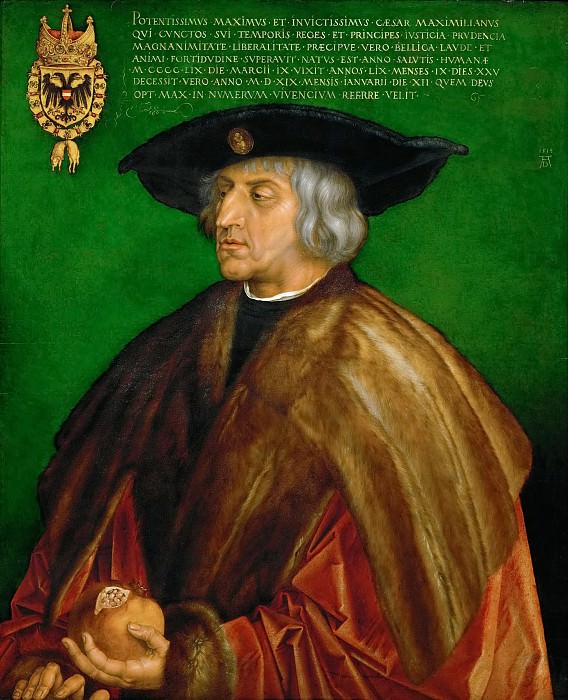Emperor Maximilian I Albrecht Dürer (1471-1528)
Albrecht Dürer – Emperor Maximilian I
Edit attribution
Image taken from other album: gallerix.org/s/1560281550/N/1264886849/
Download full size: 2518×3107 px (2,8 Mb)
Painter: Albrecht Dürer
Location: Museum of Art History, Vienna (Kunsthistorisches Museum).
Albrecht Dürer was born into a large family and his path to recognition was a thorny one. The artist married mainly for the notion of his social status; for a long time his income was the sale of engravings. At a mature age the artist acquired a patron, who became Maximilian I. Under his control the author worked on the Arc de Triomphe. At this period Dürer painted several pictures with the emperor.
Description of the painting "Portrait of Maximilian I" by Albrecht Dürer
Albrecht Dürer was born into a large family and his path to recognition was a thorny one. The artist married mainly for the notion of his social status; for a long time his income was the sale of engravings. At a mature age the artist acquired a patron, who became Maximilian I. Under his control the author worked on the Arc de Triomphe. At this period Dürer painted several pictures with the emperor. One such work is a portrait of Maximilian I.
The picture depicts the emperor. He is dressed in a luxurious mantle with a fur collar. On his head is a classic for that time hat. The haughty expression on his face attracts attention. The emperor was dissatisfied with something, it was characteristic of the ruler, he had a very complex character. Maximilian’s lips are pressed together and his eyes are half-closed. The arrogance reeked from the portrait. The emperor was pleased with Dürer’s painting.
The treasury was empty, the ruler was not always able to pay for the artist’s services on time. He even offered to relieve him of taxes, but the Senate refused the request. Then the generous patron appointed the artist a pension for life. If the portrait satisfied Maximilian, the emperor saw himself exactly as Dürer portrayed him. In his hand the patron holds a pomegranate. Since ancient times this fruit has been considered a symbol of immortality, rebirth and abundance.
Maximilian considered himself great and invincible, he believed in immortality. As ruler, he held the fruit in his hand, which bodes well for fertility and prosperity. It is the emperor who controls these processes; he is all-powerful. Part of the peel on the fruit is peeled and juicy grains are visible. This signifies the multiplicity of personality, which is a torment for Maximilian.
The pomegranate also symbolizes the union of the multitude under the patronage of the church. It was Maximilian who held all power in his hand, which Dürer depicted so accurately and realistically.
Кому понравилось
Пожалуйста, подождите
На эту операцию может потребоваться несколько секунд.
Информация появится в новом окне,
если открытие новых окон не запрещено в настройках вашего браузера.
You need to login
Для работы с коллекциями – пожалуйста, войдите в аккаунт (open in new window).




















COMMENTS: 3 Ответы
Народ! Кто знает, что символизирует плод граната в руке императора?
Плод граната символизирует империю.
роман ТАМ НАПИСАНО
You cannot comment Why?
Perhaps it’s a close up of a painting of a man wearing a black hat and a brown coat and holding a piece of fruit in one hand and a crest on a green background.